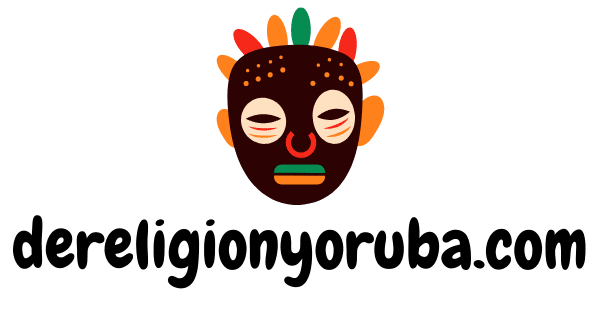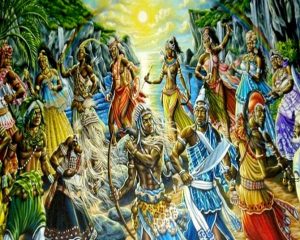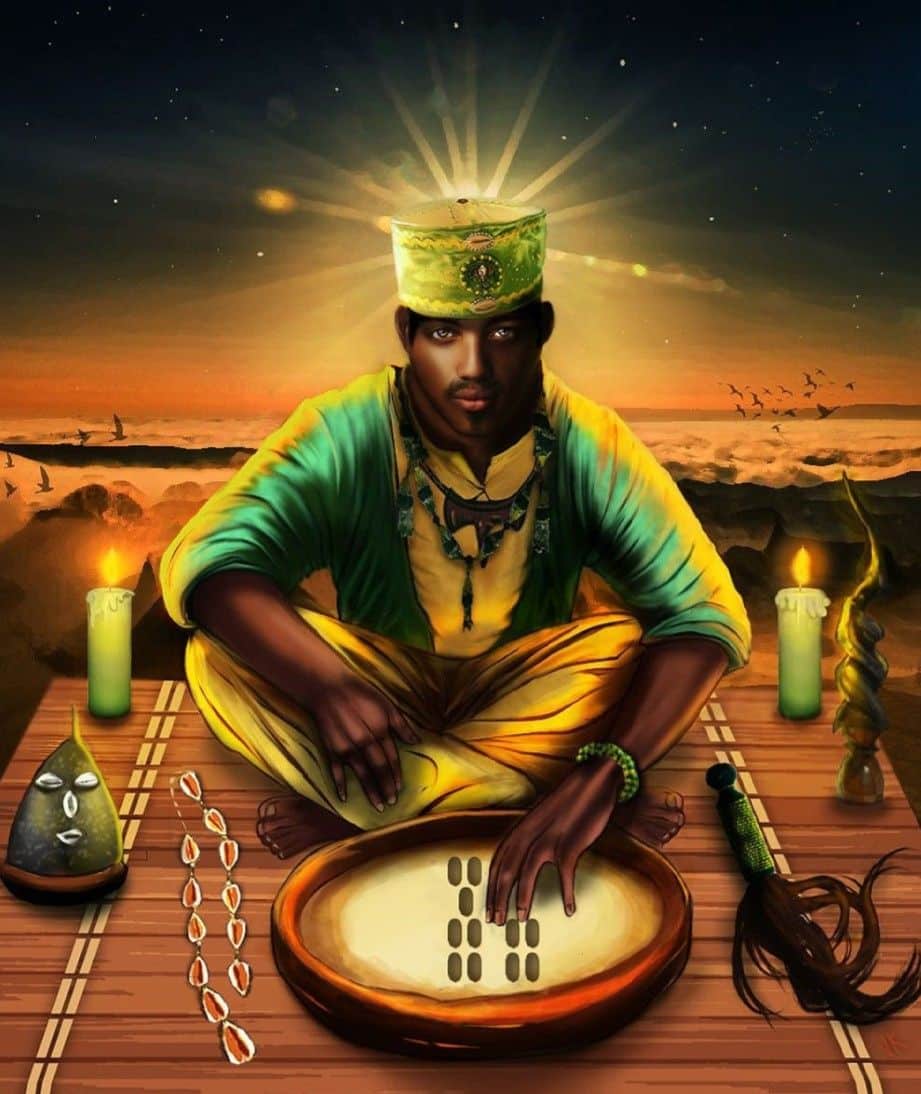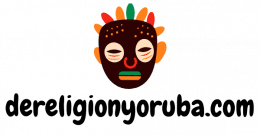YORUBA RELIGION:MEANING, CREATION, DEITIES, BELIEFS AND EXPANSION
WHAT IS THE YORUBA RELIGION?
The Yoruba Religion is an ancient tradition that has been passed down from generation to generation in West Africa. Yoruba Religion is a combination of religious beliefs and practices that have been influenced by different cultures and religions over the centuries. In this website, we will explore the richness of this tradition, with a special emphasis on its two main practices: Osha and Ifa.
Osha is a branch of Yoruba Religion that focuses on the worship and adoration of the Orishas, gods and goddesses that represent different aspects of nature and human life. Cada Orisha tiene su propio símbolo, color y personalidad.
On the other hand, Ifa is a divination practice based on consultation with the Orunmila and is used to obtain advice and guidance on important life issues. Divination is done through the Ifa board and is considered a form of direct communication with Orunmila, who is the diviner of the Yoruba religion and its different branches.
A lo largo de este sitio web exploraremos en profundidad la práctica de Osha e Ifá y descubriremos cómo afectan estas prácticas a la vida de los religiosos yoruba. We will also learn about the rites and traditions that make up this tradition, as well as its history and how it’s influenced other cultures and religions.
HOW THE YORUBA RELIGION CAME TO EXIST
Originating in south-western Nigeria and spreading throughout West Africa and the Caribbean, the Yoruba religion is an ancient and rich tradition. The Yoruba Religion is estimated to be over 5000 years old and is one of the oldest and most diverse religions in Africa.
The religion originated in an agrarian culture and an urban tribe. They had a vision of life and nature that focused on balance and harmony. Belief in the Orishas, gods and goddesses representing different aspects of nature and human life, was central to this vision, and these divine beings were worshipped and consulted for advice and guidance in daily life.
The Yoruba Religion expanded and evolved over the centuries, and over time, merged with other traditions and religions, including Catholicism and Islam, to create a unique and diverse form of worship. Today, the Yoruba religion is a living and vibrant tradition practised around the world, remaining true to its roots while adapting to the needs and challenges of modern life.
BRANCHES OF THE YORUBA RELIGION
In the Yoruba religion there are several branches or traditions, each with its own interpretation and approach to religious practice. Some of the most common branches of the Yoruba religion are as follows
- Traditional Yoruba: This is the indigenous belief system of the Yoruba peoples in West Africa. It includes the veneration of a supreme deity known as Olodumare, as well as numerous minor deities or spirits known as Orishas. The Ifa divination system is also an integral part of this practice.
- Santería (Regla de Ocha): This is a syncretic form of the Yoruba religion that developed in Cuba and other parts of the Caribbean. It combines elements of Yoruba religion with aspects of Roman Catholicism and, often, with Native American beliefs.
- Candomblé: Originating in Brazil, Candomblé is another syncretic form of the Yoruba religion that combines Yoruba beliefs, Catholicism and, sometimes, Brazilian indigenous beliefs.
- Lucumí: This term is sometimes used to refer to the form of the Yoruba religion practiced in Cuba, although it is often used specifically to refer to the dialect of the Yoruba language used in Santeria religious ceremonies.
- Ifá: Although Ifa is an integral part of all forms of Yoruba religion, it is sometimes considered a «branch» in itself because of its specific focus on divination and the wisdom provided by the Orisha Orunmila.
These are just some of the most common branches of the Yoruba religion, and there may be many other variations and traditions within the community of followers of this religion. Each branch may have its own practices, ceremonies and beliefs, although all share a common basis in the Yoruba tradition.
YORUBA RELIGION DEITIES
The Yoruba Religion includes a variety of Orisha and secondary deities, each with a unique name and distinctive personality. Here is a list of some of the better known Orishas and their significance in the Yoruba religion:
- Oyá: Goddess of death and transformation. Invoked to guide spirits to eternal rest, it is associated with strong winds and storms.
- Shangó: The god of thunder and fire. He is associated with thunder and war, and is worshipped as a protector against any war or hardship and the welfare of the person.
- Yemayá: The goddess of the sea. It is associated with motherhood and protection, and is invoked to protect sailors and bless families.
- Eleguá:The god of the paths and crossroads of each person’s life. He is associated with protection and good luck, and is considered the protector of travellers and the overseer of entrances and exits.
- Oshún: The goddess of the river. She is associated with sensuality and joy, and is worshipped as the protector of life and love. The goddess of love and beauty. It is associated with sensuality and femininity, and is invoked to bless love relationships and business ventures.
- Obatalá: The god of creation and wisdom. He is associated with peace and wisdom, and is considered the creator of human beings.
- Orunmila: The Orisha of divination and wisdom. It is associated with wisdom and prophecy, and is invoked to help practitioners make important life decisions.
- Oggún: He is associated with forging, war and agriculture, and is considered the protector of manual labourers and warriors. He is said to be a strong and courageous Orisha, but he can also be impatient and defiant.
- Olodumare: The Supreme Being and creator of the universe.
- Olorun: The Orisha of the heavens and the owner of the sun.
- Babalú Ayé: The Orisha of illness and healing.
- Ibeji: The Orishas twins, who represent youth and joy.
- Osain: The Orisha of plants and medicinal herbs.
- Ochosi: The Orisha of hunting and justice.
- Nana Bukuru: The Orisha of wisdom and healing.
- Ikú: The Orisha of death and the end of cycles.
- Inle: The Orisha of water bodies, storms and floods.
- Abita: Represents the Christian devil.
- Yewa: Oricha owner of the cemetery
- Olokun: Oricha of the seas and wealth.
- Aina: Oricha that is associated with the desire to extinguish candles (wars).
- Orisha Oko: Orisha of agriculture and prosperity.
- Ildeú: Oricha of prosperity.
- Eshu Baragriñan: Oricha of tests and decisions.
This list includes only some of the most important Orishas in the Yoruba religion. There are many other Orishas, each with their own personality and unique attributes, and each is worshipped and consulted differently by practitioners of the religion. The Yoruba religion is a vibrant and complex tradition, and the Orishas play a central role in its practice and culture.
DIVINATORY MEANS IN THE YORUBA RELIGION
In the Yoruba religion there are various divinatory means used to know the future or to receive advice and guidance in life. Some of the best known means of divination are:
- Epkuele: The «Epkuele», also known as «Ekuele» or «Okuele», is a crucial divination instrument in the practice of Ifa within the Yoruba religion. Babalawos, or Ifa priests, use the Epkuele to communicate with Orunmila (also known as Orula), the Orisha of wisdom and divination. Through Orunmila, Babalawos can contact and obtain guidance from the other Orishas. The Epkuele is composed of a chain of eight segments, often made of Kola nut shells, although they can also be made of bone, ivory or metal. Each segment can have two positions, creating a binary system that can form one of 256 possible patterns, or Odu. These Odu are interpreted to provide advice and clarity about future and current events.
When performing divination with the Epkuele, the Babalawo seeks guidance from Orunmila and the other Orishas to make decisions, solve problems and better understand the world. In summary, the Epkuele is an essential tool in the spiritual practice of the Yoruba religion, providing direct communication between practitioners and the Orisha through Orunmila.
- The Ifa Tablet: It is an object of divinatory consultation used in the Yoruba religion to predict the future and to receive advice and spiritual guidance. It consists of a board with 16 specific geometric figures, each with a different meaning. Ifa priests, called babalawos, use the Ifa board to perform divinatory readings and receive messages from the Orichas, important spiritual deities in the Yoruba religion. The Ifa board is a fundamental element in the religious practice of the Yoruba tradition.
- Diloggun:It is a divination system that uses sea shells to predict the future where the absolute owner of the diloggun is Elegguá. The soothsayer, known as olorisha, performs a ritual and consults the shells to receive information and guidance about the life of the querent.
- Obí: It is a divination system that is performed with coconut pulp to predict the future and receive information about the destiny and life of the querent. It can be used in various ceremonies within the Yoruba religion.
- Obi Ibo: It is a divination system that uses animal bones to predict the future and receive information about the life of the querent.
These are just some of the divinatory means that exist within the Yoruba religion. Each of them has its own specific methodology and symbolism, and are used in different situations to obtain answers and guidance about the future and life.
LANGUAGE
The main language of the Yoruba religion is Yoruba, an African language spoken by some 20 million people in Nigeria, Benin and Togo. Although in the African diaspora, including Latin America, Spanish and Portuguese are also widely used in religious practice and communication among followers of the Yoruba religion. In general, Yoruba is considered sacred and is used in rituals, invocations and in the transmission of knowledge through the ages.
OFFERINGS USED IN THE YORUBA, OSHA AND IFA RELIGIONS
In the Yoruba religion, offerings are a way of honouring and acknowledging the Orishas, and are a fundamental part of religious practice. Some of the most common offerings used in the Yoruba religion include:
- Food: The Orishas are offered food, such as fruits, vegetables, meat, fish, rice, etc.
- Water: Fresh water is a common offering to many Orishas, especially to Yemayá, the queen of the sea.
- Candles: Candles are offered to the Orisha as a way of providing light and warmth.
- Flowers: Fresh flowers are a common offering to many orishas, especially to Oshún, the goddess of love and rivers.
- Perfumes: Perfumes and essential oils are used to perfume the offerings and temples of the Orishas.
- Musical instruments: The Orishas are offered musical instruments such as drums, maracas, etc. as a way of honouring them and providing them with music and dances.
- Animals: Animals such as goats, sheep, roosters, chickens, pigeons and others are offered to the Orishas in specific sacrifices.
These offerings are a token of gratitude and respect to the Orishas, and it is hoped that the Orishas will bless and protect their returning followers. Each offering is carefully prepared and made with the intention of honouring the Orisha in a proper way.
EXPANSION AND SYNCRETIZATION
The Yoruba religion is one of the most widespread religions of African tradition in the world. It is venerated mainly in Nigeria, Benin, Togo and Cuba, and is also found in countries such as Brazil, Venezuela, the United States and other Latin American countries.
In Nigeria, the Yoruba religion is practised in its original form and is considered an integral part of the local culture and tradition. In Benin, Togo and some regions of Nigeria, the Yoruba religion merged with Vodou and became a form of Afro-syncretic religion.
In Cuba, the Yoruba religion merged with Catholicism and became Santeria, a syncretic religion that combines elements of the Yoruba religion with Catholic practices. In Brazil, the Yoruba religion merged with candomblé and became a syncretic religion known as Umbanda.
In the United States and other Latin American countries, the Yoruba religion merged with various African-American religions and became a form of syncretic religion known as Lucumí.



